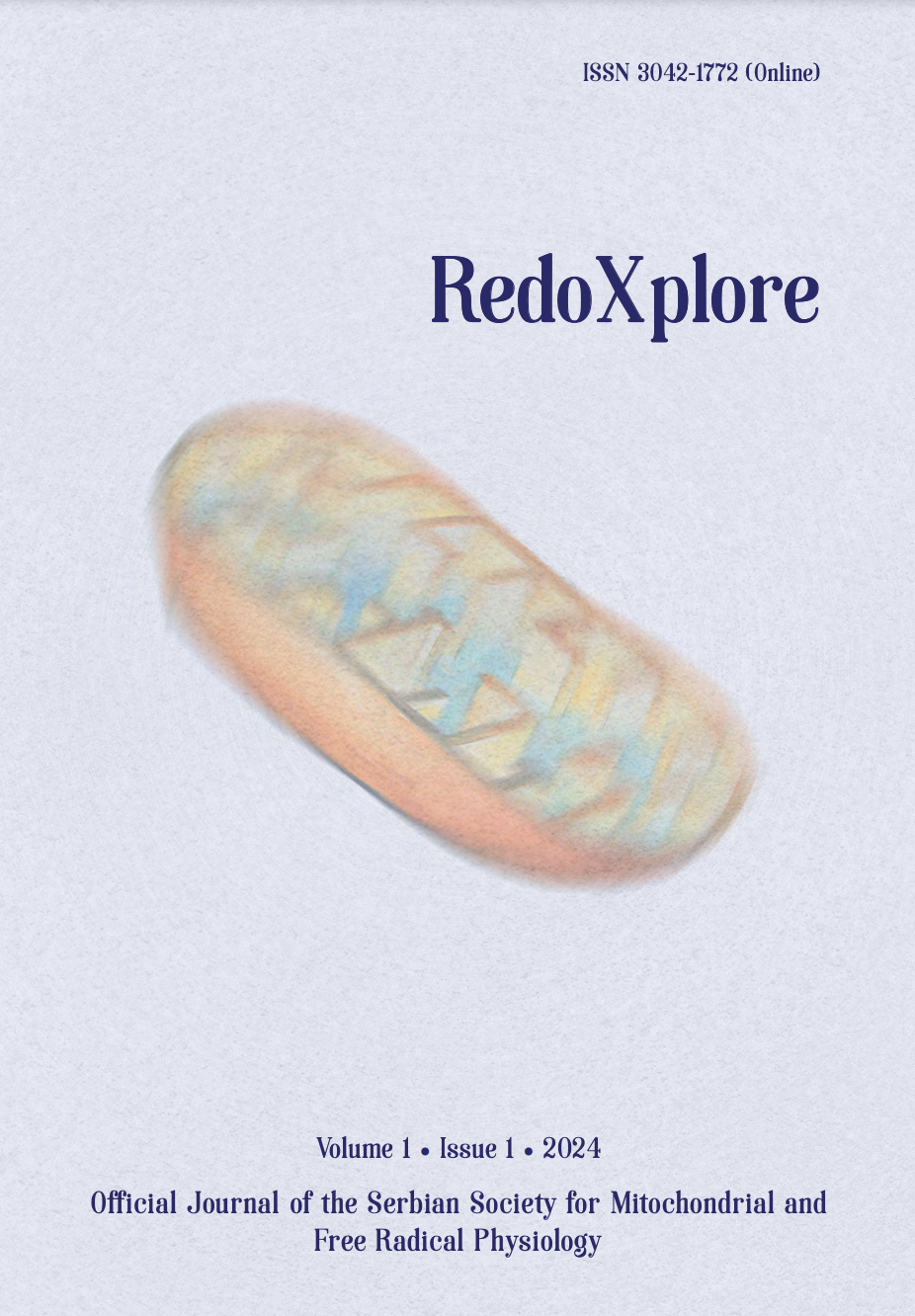
More articles from Volume 1, Issue 1, 2024
REDOX AND METABOLIC REPROGRAMMING OF BREAST CANCER CELLS AND ASSOCIATED ADIPOSE TISSUE - THE CORNERSTONES OF ADAPTIVE TUMOUR BEHAVIOUR
INSULIN MODULATES MITOCHONDRIAL STRUCTURAL AND FUNCTIONAL MOSAICISM IN BROWN ADIPOCYTES
NITRITE MITIGATES OXIDATIVE BURST IN ISCHEMIA/REPERFUSION IN BRAIN SLICES
NITRIC OXIDE, SUPEROXIDE AND PEROXYNITRITE – REDOX REGULATION OF THE CARDIOVASCULAR SYSTEM BY NITRO-OXIDATIVE STRESS AND S-NITROS(YL)ATION
DIETARY NITRATE AS PIVOT ON THE GUT MICROBIOTA-HOST REDOX COMMUNICATION
ARTIFICIAL LIGHT DISRUPTS NATURAL DAY/NIGHT VARIATION IN ANTIOXIDANT SYSTEM OF TREE FROG (HYLA ARBOREA)
Department of Physiology, Institute for Biological Research “Siniša Stanković” – National Institute of Republic of Serbia, University of Belgrade , Belgrade , Serbia
Department of Physiology, Institute for Biological Research “Siniša Stanković” – National Institute of Republic of Serbia, University of Belgrade , Belgrade , Serbia
Department of Physiology, Institute for Biological Research “Siniša Stanković” – National Institute of Republic of Serbia, University of Belgrade , Belgrade , Serbia
Department of Physiology, Institute for Biological Research “Siniša Stanković” – National Institute of Republic of Serbia, University of Belgrade , Belgrade , Serbia
Department of Physiology, Institute for Biological Research “Siniša Stanković” – National Institute of Republic of Serbia, University of Belgrade , Belgrade , Serbia
Institute for Biological Research “Siniša Stanković” – National Institute of Republic of Serbia, Department of Evolutionary Biology, University of Belgrade , Belgrade , Serbia
Department of Evolutionary Biology, Institute for Biological Research “Siniša Stanković” – National Institute of Republic of Serbia, University of Belgrade , Belgrade , Serbia
Department of Evolutionary Biology, Institute for Biological Research “Siniša Stanković” – National Institute of Republic of Serbia, University of Belgrade , Belgrade , Serbia
Faculty of Biology, University of Belgrade , Belgrade , Serbia
Department of Evolutionary Biology, Institute for Biological Research “Siniša Stanković” – National Institute of Republic of Serbia, University of Belgrade , Belgrade , Serbia
Department of Physiology, Institute for Biological Research “Siniša Stanković” – National Institute of Republic of Serbia, University of Belgrade , Belgrade , Serbia
Editor: Bato Korac
Published: 29.08.2024.
Short oral presentations
Volume 1, Issue 1 (2024)
Abstract
One of the adaptive features that organisms developed throughout their long natural history is the ability to change the activity of cells, tissues, and organs on a daily, 24-hour, basis. These cyclical changes are synchronized to the external environment through a light-dark regime and internal circadian clock. Daily recurring environmental changes are followed by variations in animal behavior and physiology, which include oscillations in neuroendocrine, metabolic, cardiovascular, and immune functions. By transforming the circadian periodicity of day, artificial light from anthropogenic sources might interfere with organisms leading to a disturbance in hormone levels and physiological stress. In this study, we investigated daily natural variations in the antioxidant system and the effects of artificial light on the redox balance in larvae of tree frogs. We compared antioxidant parameters in tadpoles from the natural day/night cycle (control) with ones exposed to artificial light at night (treatment). The antioxidant response was measured at four time points during 24h (morning, day, evening, and night). Our results showed that only GR activity did not display day/night changes nor was affected by night illumination. For GSH-Px and GST we reported changes in activity at different times of day that were in the same manner for both treatment and control. The highest values were in the morning compared to the other time points. Variation during 24h was also observed for SOD, CAT and GSH. However, exposure to night light affected the pattern and intensity of these parameters compared to the control group. Overall our study suggests that daily differences in metabolic activity can result in variations in the antioxidant system and that the presence of artificial light affects these changes. The disrupted natural rhythm of the antioxidant response may further reflect on other physiological processes and lead to a state of oxidative stress.
Citation
Copyright

This work is licensed under a Creative Commons Attribution-NonCommercial-ShareAlike 4.0 International License.
Article metrics
The statements, opinions and data contained in the journal are solely those of the individual authors and contributors and not of the publisher and the editor(s). We stay neutral with regard to jurisdictional claims in published maps and institutional affiliations.






